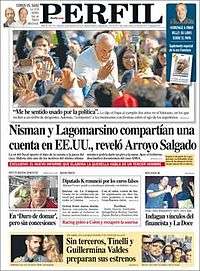Perfil
Perfil is an Argentine tabloid newspaper based in Buenos Aires.
 The front page of Perfil 15 March 2015. | |
| Type | Newspaper |
|---|---|
| Format | News |
| Owner(s) | Editorial Perfil |
| Publisher | Jorge Fontevecchia |
| Founded | 1998 (original) 2005 (relaunch) |
| Political alignment | Social democracy |
| Language | Spanish |
| Ceased publication | 1998 (original) |
| Headquarters | Buenos Aires, Argentina |
| Website | www.perfil.com |
History
The newspaper was first launched by Jorge Fontevecchia on 9 May 1998 as a daily newspaper, but poor sales forced its closure on 31 July of the same year.[1]
Perfil was relaunched on 11 September 2005 as a weekly newspaper, published on the day of highest sales, Sundays. The expectation was that after building a reader base they would be able to add a new edition on Saturdays, and finally become a daily newspaper again.
It is currently published on weekends, and has an online edition which is updated every day. In addition, the Sunday edition includes the women's magazine Luz.
Features
Like many European newspapers it includes a section called the "Reader's Ombudsman", with the responsibility of maintaining the newspaper's reputation. Abel González was the first ombudsman in 1998. From 2005 until 15 December 2007, the journalist and neurologist Nelson Castro held that position. Andrew Graham-Yooll, formerly the chief editor of the Buenos Aires Herald, is the current ombudsman.
Editorial line
Perfil's slogan is Periodismo puro (Spanish: "pure journalism"). Jorge Fontevecchia said that "Pure or technical journalism is always critical, like American 'watchdog' journalism". Despite the implication of total objectivity, the newspaper is strongly critical of the national government. Many of the articles, both in the printed edition and on the website, focus on critics of the government and of President Cristina Fernández.[2]
Editorial Perfil is one of a number of publishing companies which do not receive any official governmental advertisements. It has claimed that the official distribution of advertising monies is "discriminatory" and a "method of persecution and exclusion" of critical media.[3]
References
- "Abrupto cierre del diario Perfil", Clarín, 01-08-1998(in Spanish)
- Editorial de Jorge Fontevecchia (in Spanish)
- "Publicidad oficial: Perfil denunció al Gobierno", Terra, 31-05-2006 (in Spanish)
External links
- Perfil (in Spanish)
- Editorial Perfil's Noticias magazine (in Spanish)
- Luz magazine (in Spanish)